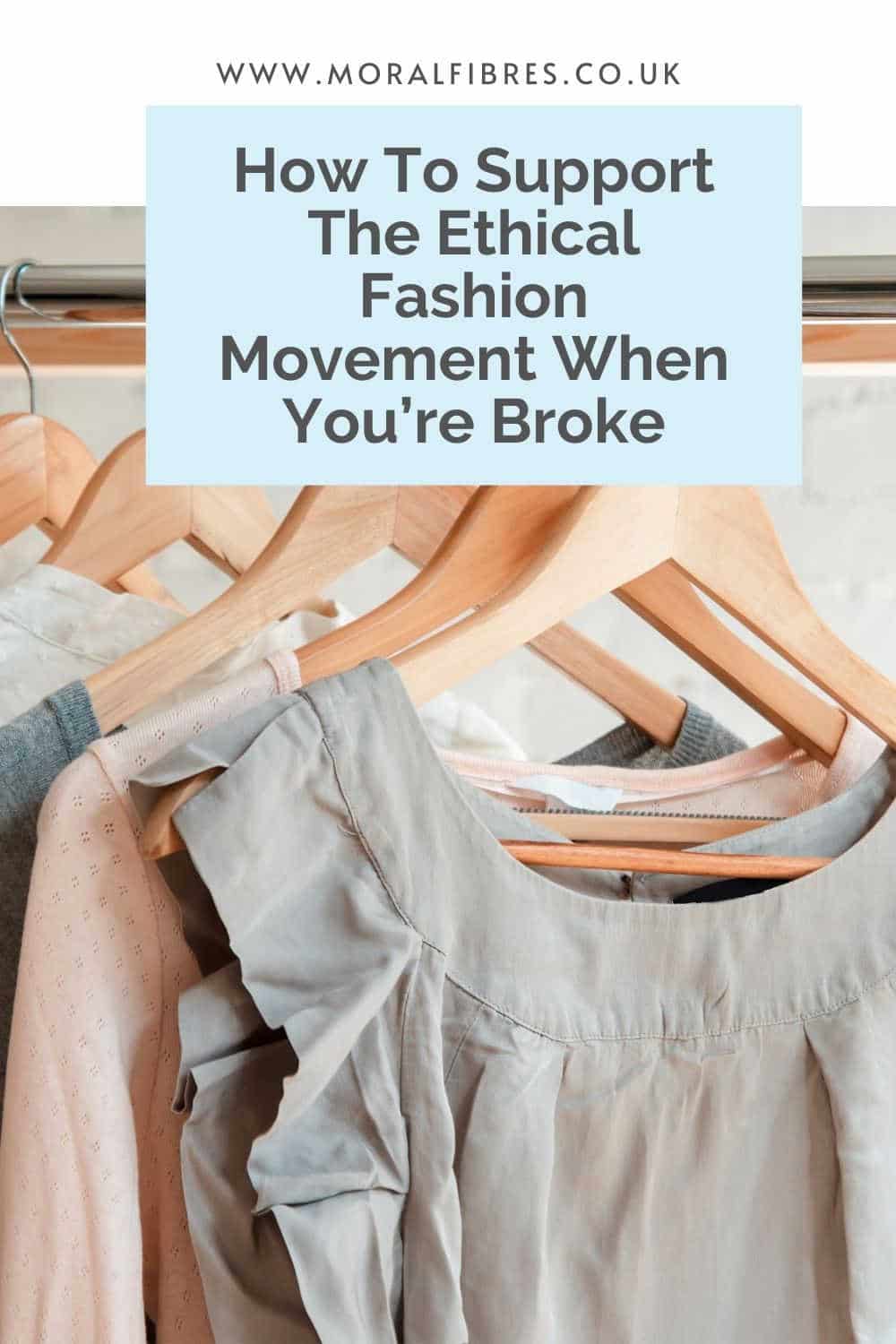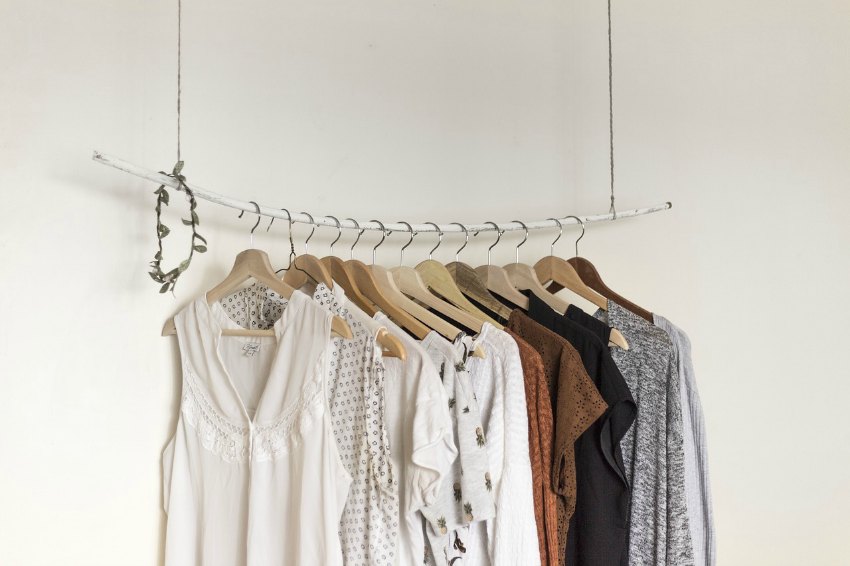How To Support The Ethical Fashion Movement When You’re Broke
To support the running costs of Moral Fibres, this post contains affiliate links. This means Moral Fibres may earn a small commission, at no extra cost to readers, on items purchased through these links.
Do you want to support the ethical fashion movement, but your bank account says no? Don’t worry. Here are seven impactful steps you can take to take action against fast fashion and support garment workers across the globe.
The rise of ethical consumer spending to over £41 billion annually – a nearly fourfold increase over the past two decades – reflects a significant shift in UK consumers’ shopping habits. More and more, people are aligning their purchases with concerns about the environment, animal welfare, social justice, and human rights.
However, despite this growing interest in ethical shopping, navigating the world of ethical consumerism, especially sustainable clothing, can be challenging. While there’s a growing number of ethical clothing brands committed to producing garments responsibly and fairly from sustainable materials, several barriers hinder would-be ethical shoppers.
Firstly, the ethical clothing market often lacks inclusivity in sizing. This leaves those above a size 16 or 18 with limited options. Additionally, there’s the issue of cost. Unless you opt for secondhand clothing, sustainable fashion typically comes with a higher price tag compared to its fast-fashion counterparts.
How to Support The Ethical Fashion Movement When You’re Broke

It’s often asked why is ethical clothing so expensive. A better way of looking at it should be asking why fast fashion is so cheap. After all, there’s no getting around the fact that if you want to buy clothes that are made fairly with eco-friendly fabrics, then you do need to pay a little more.
If your budget doesn’t stretch to new purchases, then the good news is you don’t necessarily need to buy ethical clothing to support the movement. There are plenty of impactful ways to contribute to ethical fashion from the ground up without breaking the bank.
Here are seven strategies to get you started. You can use the quick links to navigate to a specific section of this post or keep scrolling for the full list.
- Look After The Clothes You Have
- Be An Outfit Repeater
- Sell, Swap Or Donate Your Old Clothes
- Shop Secondhand
- Support Garment Workers
- Have Conversations Around Ethical Fashion
- Call Out Greenwashing
Look After The Clothes You Have
The single most sustainable clothes are the ones you already own. After all, producing a single t-shirt can gulp down a whopping 2700 litres of water. So, by extending the lifespan of your existing garments, you’re doing much more for the environment than any new purchase could achieve. Plus, taking good care of your clothes and opting to buy less actively weakens the grip of the fast fashion industry.
It’s simple to prolong the life of your clothes. Washing your clothes less is the ultimate lazy way to do so. When you do need to wash them, simply wash and dry your clothes according to their care labels. Treating stains when they arise, rather than letting them set also helps prevent our clothes from becoming unwearable.
Another key aspect is repairing our clothes when rips or tears arise. Nadia Piechestein, the sustainable fashion designer behind TLZ Movement, uses offcuts from her work in alterations and repairs, to create zero-waste patches for people to mend their clothes with.
Nadia says it’s important to mend the clothes we own because it helps minimise our impact on the planet. Her easy-fix advice is to use patches to cover up holes. Nadia says “It gives a personalised style and you can go out proudly saying that your garments were reworked”.
Be An Outfit Repeater
The rise of social media has seen our thirst for new clothing reach extreme levels. Instagram’s “outfit of the day” hashtag (#OOTD) encourages dysfunctional clothing consumption levels. We’re now at the point where one in six young people say that they don’t feel they can wear an outfit again once it’s been seen on social media.
Lianne Bell, author of the book How On Earth Can I Be Eco-Friendly attributes the problem to the cost and availability of fast fashion.
Bell says in this article for Moral Fibres: “We’ve come to think of clothing as disposable and easily replaceable. When something is so readily available to us, it devalues the whole item.”
Rewearing the clothes we have seems hardly revolutionary, but it’s a key way to help halt the rise of fast fashion. Simply committing to re-wearing the clothes you already own for as long as possible can disrupt the fast fashion industry – an industry that relies on people buying new clothes as often as possible.
Sell, Swap Or Donate Your Old Clothes
In an ideal world, we would all wear our clothes until they were no longer repairable. However, life never stays the same. Body sizes change, lifestyles change, and tastes change. In these instances, selling or passing on our clothes helps disrupt the fast fashion market.
It’s never been easier to do so, and there are many sites where you can sell preloved clothes online. Alternatively, you can swap clothes with friends, or through organised clothes swaps in your local community. This is a great way to keep clothing out of landfill, build an ethical fashion wardrobe, and reduce our reliance on fast fashion.
If you are donating clothing, remember that charity shops aren’t waste disposal units. Charity shops want clean, good-quality clothing from desirable brands. Before donating, ask yourself if you would honestly buy the item you are planning to donate. If not, then here are ideas on what to do with clothes that can’t be donated to charity.
Shop Secondhand
Buying second-hand is one of the easiest ways for consumers to understand that they are choosing a more sustainable option than buying new. It’s also one of the most affordable ways to take part in ethical fashion.
Shopping secondhand does have its barriers. It can be tricky to find inclusive sizing on the rails of your local charity shop. Meanwhile, men’s options can be limited.
The good news is that there is a proliferation of secondhand shopping sites online – from eBay to Depop and everything in between. You can even shop Oxfam Online. Here proceeds support their work on fighting poverty and injustice across the globe. You do tend to find more options online, with many sites having healthy plus-size and men’s clothing sections.
Support Garment Workers
A key way to help bring about change in the fashion industry is to help support garment workers across the globe, who are often underpaid and working in poor conditions.
That may sound like a tricky ask. However, organisations like the Clean Clothes Campaign and the Workers Rights Consortium run campaigns that you can easily join to help press for better conditions for garment workers.
From issues like wage theft and forced labour, to workplace health and safety, and gender-based violence and discrimination – by supporting these organisations you can help bring about much-needed change.
Have Conversations Around Ethical Fashion
Having conversations with fashion brands that you think should be doing better is another key way to support the ethical fashion movement from the ground up.
Fashion Revolution’s Who Made My Clothes campaign, for example, encourages people to ask brands via email or social media, who made the clothes they are wearing, or the fabric their clothes are made from.
This challenges brands to protect the people in their supply chains. It also encourages them to take responsibility for the human rights and well-being of everyone involved in the manufacturing process, from farm to factory to finished garment.
You don’t have to end the discussion there. Keep the conversation going by chatting with your friends and family about why supporting ethical fashion doesn’t just mean buying a pair of jeans made from organic cotton.
After all, ethical fashion goes beyond the material of our clothes—it encompasses a whole spectrum of considerations. It’s about understanding the entire journey of a garment, from its supply chain and life cycle (including our options for recycling when the item we’ve bought reaches the end of its life) to a brand’s business practices.
Call Out Greenwashing
Finally, it’s important to call out greenwashing when you see it. Greenwashing is when a brand conveys misleading information that its products are environmentally friendly.
It’s rife in the fast fashion industry. Brands rooted in promoting hyper-consumption, like H&M, BooHoo, and Primark, have all launched lines with a sustainable facade. These often small collections – in the case of Primark, its ‘sustainable range’ comprised of just 8 items – and are partly made with recycled or organic materials. They’re then sold alongside these brands’ standard options.
The real issue here though is scale. As of April 2024, if you take a look at H&M’s website you’ll find a staggering 10,008 women’s clothing items up for grabs, with 1,995 of them being brand-new arrivals.
This manufacturing frenzy is simply unsustainable for our planet. Sure, tossing in a few items made partly from organic cotton might seem like a step in the right direction, but let’s not kid ourselves—it won’t save the planet. What these brands really need to do is ditch their fast-fashion business model.
It’s time to call out this kind of greenwashing when we spot it. By doing so, we help others see through the flimsy facade and realise there are far better ways to support the ethical fashion movement than falling for the allure of a “conscious” t-shirt from a fast-fashion brand.
Final Thoughts
If we truly aim to dismantle the systems that exploit communities and the environments, we must recognise that our consumer choices are just a tiny fraction of the puzzle.
It’s the actions we take and the conversations we engage in that wield real power. These ripple out into the wider world, bringing about positive shifts in the ethical fashion landscape from grassroots levels.
These shifts can range from advocating for fair wages and improved working conditions for garment workers to reducing waste and reducing our impulse to constantly buy new clothes. It’s a win-win for both people and the planet—and it doesn’t have to break the bank.
Found this post useful? Please consider buying me a virtual coffee to help support the site’s running costs.




